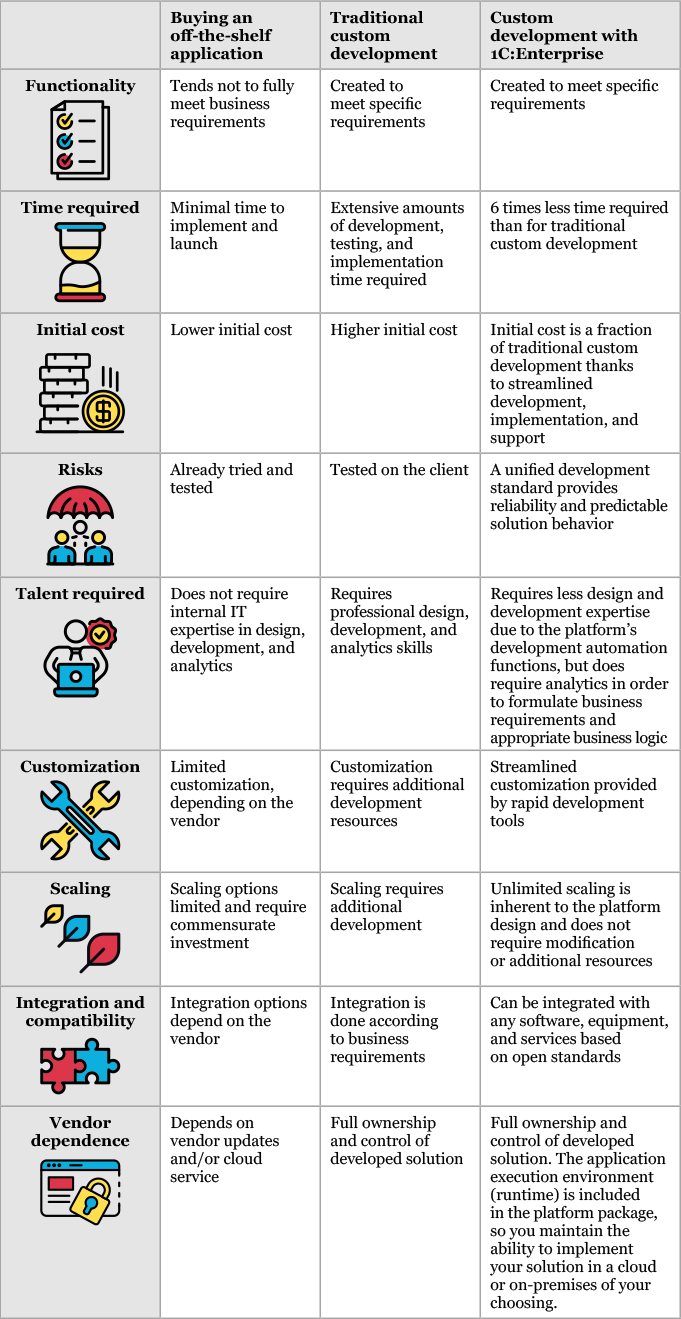
Picking the right software is key for a changing business. The first step is choosing the implementation model — build or buy. Building implies custom development, creating a solution that suits your particular business needs. Buying refers to an off-the-shelf business application that is ready to go immediately.
Both models have their pros and cons. As with anything, there are exceptions to every rule, but the advantages and disadvantages described below apply to the vast majority of cases.
Buy
Pros
- Lower startup costs.
Economies of scale spread development costs between a lot of customers. However, you’ll need to take into account the hidden costs of having to change business processes around ready-made software, as well as additional development to fine-tune the software to your needs. -
No development time required.
However, selecting the right application, or fine-tuning one to meet your needs, can be time-consuming in and of itself. -
Tried-and-true solutions.
You will be able to see reviews from other users in the industry, as well as try out the application before buying. -
Less IT support required.
Your internal IT team will not need to possess the design, analytics, and development talent needed for a custom solution.
Cons
-
Lack of unique advantages.
Even if you’ve found a solution that meets your particular business needs, it won’t be unique to you. Using a mass-market application means that your business processes and ideas can be easily copied by your competitors. -
Vendor dependence.
This is particularly relevant for cloud services, as you won’t own the software. Buying an off-the-shelf on-premises solution still doesn’t guarantee complete control — updates and changes will be entirely at the vendor’s discretion. This can have unforeseen consequences if features you rely on are deprecated. -
Lack of flexibility and scalability.
Off-the-shelf applications are difficult to scale up and modify. As your business grows and changes, you will be unable to expand and modify your software without incurring additional costs. -
Integration issues.
It’s likely that your legacy systems or business hardware will not be immediately compatible with an off-the-shelf application suite.
Custom development
Pros
- A solution specific to your needs.
A unique software product that provides competitive advantages. -
Bloat-free software.
The specific functions that your company needs, without superfluous clutter and confusion. -
Independence and control.
The product belongs to and is managed by you. -
Easy scaling and modification.
Custom development means that your software can keep up with your business.
Cons
- Cost.
All development costs are carried by a single customer. -
Development time.
Creating a solution from scratch, integrating with your existing systems, testing the builds, and rolling it out can take multiple business cycles. -
Untested solution.
You’ll be the first to find out what works and what doesn’t, regardless of whether your business can afford the time. - Support and updates for a custom product are subject to additional negotiations and contracting with the developer. Unlike off-the-shelf software, where support usually comes standard with the software license or service agreement, custom-made software is not supported by default.
There is no universal answer to the question of whether custom or off-the-shelf software is better. The answer in any given case depends on your circumstances, requirements, and plans for the future. However, the guidelines below can help you narrow down a decision.
Factors to take into account when deciding between business software implementation models
Do you need to automate a short-term need or are you looking for a solution to support your long-term strategy? Off-the-shelf software is often well-suited for specific short-term tasks, but does not always provide value in the long term. Limited scalability and customization may not keep up with your business growth. Over the long term, mass-market software may also lose its cost advantage over custom solutions due to needing additional resources to provide support, service, and configuration after the initial license runs out.
How unique are your internal business processes? Custom development is perfectly suited for companies with unique business processes that require complex back-office systems, such as ERP, SCM, BPM, and CRM. If your business processes are less particular to your company, it may be wiser to purchase off-the-shelf applications or go for a combined approach. For example, it is sensible to automate standard processes, such as accounting, with standard software, while turning to custom development to support processes that are more specific to your business, such as manufacturing or maintеinance.
Are your unique business processes critical for your competitive advantage? As a rule, a number of business applications have already been developed for every industry. However, off-the-shelf applications are aimed at a wide range of users and tend to standardize business processes. Using off-the-shelf business applications necessarily means implementing business processes in the form in which they are offered by those applications. That may cause a company to lose its uniqueness, costing it its advantage in a highly competitive field. In the words of the founder of a food retail chain:
Even if you’re just selling milk, you can’t just buy ready-made software to manage your business. Differentiating yourself requires creating an IT product. Our business is particular in ways that make us special, and there are simply no ready-made IT solutions that fit our processes. I tried, at first, to work with a certain consulting agency and modify their solution to our needs. That cost us a lot of time and resources without achieving anything worthwhile. It became clear that we had to create our software from scratch.
If it looks like you would benefit more from a custom solution, you can minimize the inherent disadvantages of from-scratch development.
Use specialized platforms to develop custom business software
As software development technology evolves, the idea of custom development as something expensive and time-consuming is becoming a thing of the past. Rapid development platforms, enabling the efficient creation and support of custom solutions, have appeared on the market. These platforms aim to optimize the development process, enabling automated handling of low-level details so that developers can focus on business logic.
In terms of the degree of abstraction, rapid development platforms range from full-stack accelerated development frameworks to no-code platforms that require neither coding nor programming skills. As a rule, the greater the degree of abstraction—the faster the development speed, and the less flexibility in implementing complex, business-specific functions.
Rapid development of multifunctional back-office systems requires a platform that is simultaneously flexible enough to provide the needed customization to serve a business’ unique needs and abstracted enough to enable fast, simplified development. These seemingly contradictory requirements are met by platforms that specialize in specific types of tasks. For example, automating chains of complex business problems and algorithms for ERP systems.
Let's examine the use of specialized platforms for back-office software development, with the 1C:Enterprise platform as an example. 1C:Enterprise was created to provide flexibility, speed, and easy development of management and accounting process automation applications.
The platform has around 20 built-in components. Most of these are business components that describe data patterns for enterprise accounting—directories, documents, charts of accounts, business process flow, etc.
Other components deal with the technological side of things. For example, web and HTTP services allow 1C applications to communicate with the outside world. Not having to write the data access layer, base UI, etc, enables developers to focus on business-specific tasks.
Those tasks are, in turn, simplified by the built-in components—support for hierarchical directories, financial and inventory accounting mechanisms, templates for complex periodic calculations, such as payroll, and much more. To implement a solution, developers fill in these components, connecting them to describe specific business logic.
Developers aren’t limited to the existing algorithms underpinning the platform's business components. The platform’s built-in high-level programming language enables tasks, such as calculating prices, taxes, costs, salaries, to be solved without the need for third-party languages and platforms.
Software development based on pre-built components allows the company to focus on implementing its specific business processes only, instead of building basic business functionality from scratch. Additionally, 1C:Enterprise offers developers the ability to streamline the entire enterprise application development life cycle.
Off-the-shelf applications vs custom development vs rapid development of custom solutions with 1C:Enterprise






